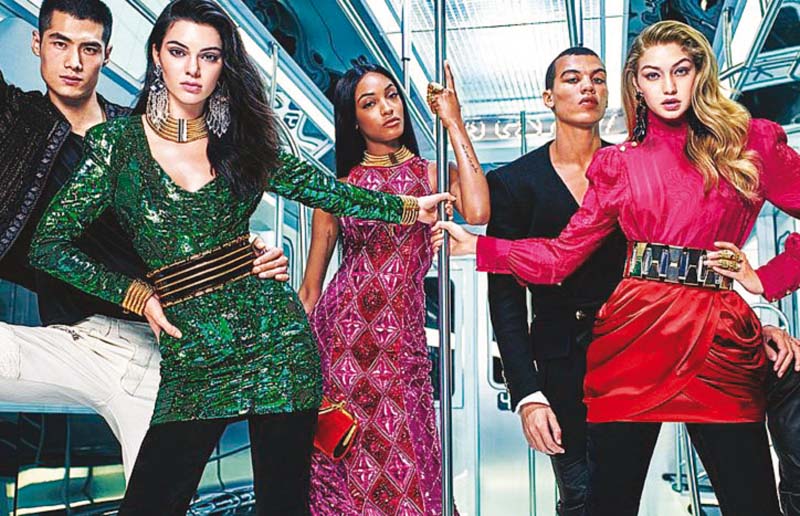
Most global high-street brands that join forces with high-end designers have witnessed lucrative results. Retail brands such as H&M boast successful collaborations with the likes of Karl Lagerfeld, Alexander Wang and Isabel Marant. With the Swedish retailer’s upcoming collaboration with Balmain keeping us on the edge of our seats, we take a retrospective look at how this high-street brand-high-end designer dichotomy has boded for the fashion scene in Pakistan.
Over the years, local designers have teamed up with textile manufacturers to create lawn collections and only occasionally collaborated with high-street/mass-market brands that are in line with their vision and mission. In 2012, Adnan Pardesy worked with clothing brand The Working Woman for a collection that featured clean cuts and simplicity of design, which was in harmony with the retail outlet’s signature style.

“I always wanted to do a collection that was more diffused and wearable. I wanted someone else to produce it but under my name, so the collaboration fit,” said Pardesy. Omar Zaman, the brand manager of Working Woman at the time of the project, cited the brand’s infancy as one of the reasons for joining hands with the fashion heavyweight. “We were trying to define a fashionable look for working women. We had a look in mind and Pardesy’s aesthetics seemed like the perfect fit,” he noted.
This or that? Parfait at Paris Fashion Week
But while such collaborations are complementary in nature, they could potentially compromise the individuality of the brand and the designer. “Since we were a new brand [at the time], we didn’t want to continually associate ourselves with a designer, as that would’ve meant risking our own standing in the market,” added Zaman about the brand’s two-year collaboration with Pardesy. “Plus, it’s not financially viable to create designer-quality apparel for the masses. Achieving the feel of designer-wear at a price suitable for them is hard to achieve.”

HSY for Stoneage winter 2009 collection
Be that as it may, teaming up with designers is a well-strategised way of gaining publicity and accessing different segments of the market. HSY for Stoneage was a 2009 alliance that saw a whole new look for the jeans brand, replete with an exciting high-end fashion shoot and a new line of winter essentials, which created just the right buzz. The HSY-Stoneage duo allowed teenage consumers to own designer outfits that many would otherwise not be able to afford. Capitalising on HSY’s brand name, Stoneage also got the chance to tap into the master couturier’s fashion-conscious clientele.
Mass-meets-prestige creates hype that permeates the media and consumers beyond a brand’s current influence. Bonanza took designers Maheen Karim and Sanam Chaudhri on board in 2013, both of whom have fun, individual takes on fashion that helped uplift the brand’s image. But this venture also bore fruit for Karim and Chaudhri, helping them become known in the country and beyond their hometown Karachi.
This or that? More Power to Power Dressing
Presenting them with large-scale production possibilities, the brand provided the designers with opportunities they wouldn’t have been able to create single-handedly. “The brand had the ability to bring production costs down. All I did was design and sampling and they did the rest,” said Karim. “[This way,] it was quicker to get thousands of things out there in the market, something I wouldn’t have been able to do on my own.”

Maheen Karim and Sanam Chaudhri for Bonanza summer 2013 collection
Brands don’t just cash in on the success of established designers but also gain mileage by collaborating with newbies. Interestingly, Sania Maskatiya’s stint with Khaadi as an intern in 2005 was her foray into the fashion world and a win-win for the parties involved. Not only are these joint ventures a source of cash injection into the design house but also allow them to experiment with category extension in a less risky and costly way. On the international front, for instance, shoe designer Jimmy Choo produced his first line of women’s clothing by joining forces with H&M and Stella McCartney collaborated with Gap Kids, which ultimately led to the launch of her own children’s-wear line.
Top 10 trends at Milan Fashion Week

On the flipside, such collaborations have a fair share of pitfalls. Designers run the risk of alienating their core customers, who may feel their brands have become devalued by becoming accessible for the masses. To this end, Karim noted, “Perhaps [this is why] these collaborations shouldn’t remain perennial and produce small collections so that their offerings remain special.”
Published in The Express Tribune, October 20th, 2015.
Like Life & Style on Facebook, follow @ETLifeandStyle on Twitter for the latest in fashion, gossip and entertainment.

















COMMENTS (1)
Comments are moderated and generally will be posted if they are on-topic and not abusive.
For more information, please see our Comments FAQ